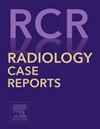Giant cellulitis-like Sweet syndrome with myofasciitis: Multimodality imaging findings and streptococcal trigger
Q4 Medicine
引用次数: 0
Abstract
Sweet syndrome is a rare neutrophilic dermatosis that can mimic infectious cellulitis. In this case, a 34-year-old woman presented to the emergency department with fever, leukocytosis, and painful erythematous right thigh plaque. She was initially started on broad-spectrum antibiotics for presumed cellulitis, but worsening systemic symptoms (including hypotension) and right thigh MR findings of myofasciitis raised concern for necrotizing soft tissue infection with systemic inflammatory response syndrome. Right thigh fasciotomy was performed, but all tissue sampling and cultures remained negative for infection. Subsequent CT and ultrasound of the right thigh revealed early myonecrosis in the setting of inflammatory myofasciitis. Skin biopsy showed papillary dermal edema and extensive interstitial neutrophilia with leukocytoclasia without microbial pathogens, consistent with a diagnosis of giant cellulitis-like Sweet syndrome. Treatment with high dose intravenous corticosteroids produced rapid clinical improvement. This case describes a rare presentation of Sweet syndrome with muscle involvement, outlines diagnostic features in the multimodality imaging of neutrophilic myofasciitis, and underscores the importance of considering Sweet syndrome in soft tissue inflammation that is unresponsive to antimicrobial therapy.
巨大蜂窝织炎样Sweet综合征合并肌筋膜炎:多模态影像学表现和链球菌触发
甜综合征是一种罕见的中性粒细胞皮肤病,可以模仿传染性蜂窝织炎。在这个病例中,一名34岁的女性以发烧、白细胞增多和疼痛的右大腿红斑斑块就诊于急诊科。患者最初因疑似蜂窝织炎开始使用广谱抗生素,但全身性症状(包括低血压)的恶化和右大腿肌筋膜炎的MR表现引起了对坏死性软组织感染伴全身性炎症反应综合征的关注。进行右大腿筋膜切开术,但所有组织取样和培养均为阴性感染。随后的CT和超声检查显示,在炎性肌筋膜炎的背景下,有早期的肌坏死。皮肤活检显示乳头状真皮水肿和广泛的间质中性粒细胞增多伴白细胞增多,无微生物病原体,符合巨大蜂窝组织炎样Sweet综合征的诊断。大剂量静脉注射皮质类固醇治疗可迅速改善临床症状。本病例描述了一例罕见的伴有肌肉受累的Sweet综合征,概述了中性粒细胞肌筋膜炎的多模态影像学诊断特征,并强调了在抗菌治疗无反应的软组织炎症中考虑Sweet综合征的重要性。
本文章由计算机程序翻译,如有差异,请以英文原文为准。
求助全文
约1分钟内获得全文
求助全文
来源期刊

Radiology Case Reports
Medicine-Radiology, Nuclear Medicine and Imaging
CiteScore
1.10
自引率
0.00%
发文量
1074
审稿时长
30 days
期刊介绍:
The content of this journal is exclusively case reports that feature diagnostic imaging. Categories in which case reports can be placed include the musculoskeletal system, spine, central nervous system, head and neck, cardiovascular, chest, gastrointestinal, genitourinary, multisystem, pediatric, emergency, women''s imaging, oncologic, normal variants, medical devices, foreign bodies, interventional radiology, nuclear medicine, molecular imaging, ultrasonography, imaging artifacts, forensic, anthropological, and medical-legal. Articles must be well-documented and include a review of the appropriate literature.
 求助内容:
求助内容: 应助结果提醒方式:
应助结果提醒方式:


